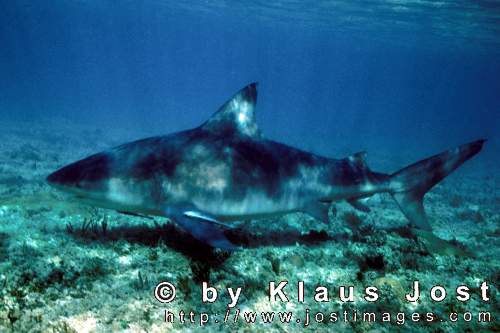Post by Vodmeister on Mar 13, 2014 22:18:52 GMT 5
Bull Shark
The bull shark, Carcharhinus leucas, also known as the bull whaler, Zambezi River shark or colloquially Zambi, is common worldwide in warm, shallow waters along coasts, and well-known for its unpredictable, often aggressive behaviour. They have a tolerance for fresh water that is unique among marine sharks, and can travel far up rivers, posing a threat to those who venture into the water. As a result they are probably responsible for the majority of attacks on humans that take place near the shore, including many attacks attributed to other species. They may be found far from the ocean but are not true freshwater sharks (unlike the river sharks of the genus Glyphis).
Bull sharks are large and stout. The males of this species can reach 2.1 metres (6.9 feet) and weigh 90 kilograms (198.4 lb). The females can be much larger: 3.5 m (11.5 ft) and 230 kg (507 lb). It is wider than other sharks of comparable length. It is grey on top and white below. The second dorsal fin is smaller than the first.

Black Caiman
The black caiman (Melanosuchus niger) is a crocodilian. It is a carnivorous reptile that lives along slow-moving rivers and lakes, in the seasonally flooded savannas of the Amazon basin, and in other freshwater habitats in South America. Once common, it was hunted to near extinction primarily for its commercially valuable hide. It is now listed as Conservation Dependent.
The black caiman has a bony ridge over red eyes, and black, scaly skin. The skin coloration helps with camouflage during its nocturnal hunts, but may also help absorb heat.
The black caiman is one of the largest reptiles. It is the largest predator in the Amazon basin and possibly the largest member of the family Alligatoridae. Most adult black caimans are 3 to 4.26 meters (10-14 feet), with old males rarely growing larger than 5 meters (16.5 ft). The black caiman broadly overlaps in size with the American Alligator, although it is on average larger at maturity. In some areas (such as the Araguaia River) this species is consistently reported at 4-5 meters (13.2-16.5 ft) in length, much larger than the Alligator (which rarely even reaches 4 meters). Several unconfirmed sources report that the black caiman can grow to 6 meters (19.8 ft) or more. It is, however, the 3rd largest crocodilian in South America behind the American Crocodile and Orinoco Crocodile.

The bull shark, Carcharhinus leucas, also known as the bull whaler, Zambezi River shark or colloquially Zambi, is common worldwide in warm, shallow waters along coasts, and well-known for its unpredictable, often aggressive behaviour. They have a tolerance for fresh water that is unique among marine sharks, and can travel far up rivers, posing a threat to those who venture into the water. As a result they are probably responsible for the majority of attacks on humans that take place near the shore, including many attacks attributed to other species. They may be found far from the ocean but are not true freshwater sharks (unlike the river sharks of the genus Glyphis).
Bull sharks are large and stout. The males of this species can reach 2.1 metres (6.9 feet) and weigh 90 kilograms (198.4 lb). The females can be much larger: 3.5 m (11.5 ft) and 230 kg (507 lb). It is wider than other sharks of comparable length. It is grey on top and white below. The second dorsal fin is smaller than the first.

Black Caiman
The black caiman (Melanosuchus niger) is a crocodilian. It is a carnivorous reptile that lives along slow-moving rivers and lakes, in the seasonally flooded savannas of the Amazon basin, and in other freshwater habitats in South America. Once common, it was hunted to near extinction primarily for its commercially valuable hide. It is now listed as Conservation Dependent.
The black caiman has a bony ridge over red eyes, and black, scaly skin. The skin coloration helps with camouflage during its nocturnal hunts, but may also help absorb heat.
The black caiman is one of the largest reptiles. It is the largest predator in the Amazon basin and possibly the largest member of the family Alligatoridae. Most adult black caimans are 3 to 4.26 meters (10-14 feet), with old males rarely growing larger than 5 meters (16.5 ft). The black caiman broadly overlaps in size with the American Alligator, although it is on average larger at maturity. In some areas (such as the Araguaia River) this species is consistently reported at 4-5 meters (13.2-16.5 ft) in length, much larger than the Alligator (which rarely even reaches 4 meters). Several unconfirmed sources report that the black caiman can grow to 6 meters (19.8 ft) or more. It is, however, the 3rd largest crocodilian in South America behind the American Crocodile and Orinoco Crocodile.







